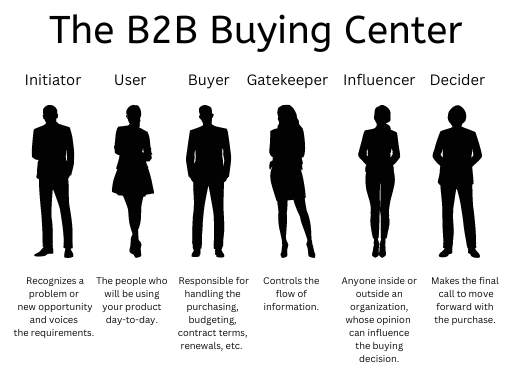B2B Email Marketing in 2025 (11 Strategies + Best Practices!)
As a B2B marketer, are you on the hunt for B2B email marketing best practices to power up your digital marketing efforts?
Or are you all like, c’mon, is email marketing even a good B2B marketing strategy?
In 2023? 🙄
💯%, amigos.
Email marketing is the number one money spinner for 93% of B2B marketers.
However, most B2B marketers make the mistake of relying too heavily on emotion-driven B2C email marketing.
B2B sales should be built on logic and reason, even if the people holding the purse strings are still human beings.
The key lies in finding that balance.
Let’s get on with it, shall we?
B2B Email Marketing Strategies
First, let’s make sure we’re all on the same page.
What is B2B email marketing?
Business-to-Business (B2B) email marketing is the act of generating and nurturing business leads via email.
You implement techniques and practices to send the right emails to the right B2B customer at the right time.
But it’s not as simple as slapping together random acts of marketing in an email.
If it was, you wouldn’t be Googling “How can I improve my B2B email marketing?” and reading this post.
So, here are eleven awesome B2B marketing strategies to implement in your next digital marketing campaign.
1. Establish your marketing goals.
Determining your B2B email marketing benchmarks is crucial — you shouldn’t be setting goals willy-nilly.
If you don’t establish exactly what you want to accomplish, how do you achieve growth and measure long-term success?
The most common goals include:
- Lead generation
- Brand awareness
- Sales
We don’t recommend setting a vague goal like “get more leads.” Instead, make it more tangible, targeted, and measurable.
For example:
“Gain 35% more email leads and 20% more phone leads for product XYZ by December.”
2. Determine your KPIs.

KPIs (Key Performance Indicators) are measurable metrics tied to the goals you’ve just set.
Choosing the right KPIs will provide user activity insights and help determine the results of your efforts.
The top 10 KPIs to track are:
- Open Rate
- Bounce Rate
- Click Through Rate
- Conversion Rate
- ROI
- Unsubscribe Rate
- Unengaged Rate
- Spam Rate
- List Growth Rate
- Engagement Over Time
If this is your first rodeo, you can use email marketing software to do all the heavy lifting.
3. Find your target audience.
With a B2B company, you're not necessarily dealing with one individual B2B buyer.
Instead, your target audience is a group of people who determine whether the company purchases your product.
Who are they?
They are the buying center.
And this powerhouse includes six primary roles:

To target each person effectively, you’ll need to understand the pain points and pressures of their role in the company.
☝️To really drill down on your targets, check out our guide for targeted email marketing. 🤓
4. Create buyer personas.
A buyer persona embodies an imagined snapshot of your ideal potential customer.
Creating buyer personas begins with understanding the companies that could benefit most from your products or services.
You want to see through the eyes of your buyer and realize their needs and pain points.
To do this, you need to:
- Identify your customers
- Understand their wants and needs
- Determine how they want to engage (and buy)
The deeper your understanding of your buyers, the more effective your email marketing will be.
And you’ll see fewer unsubscribes or spam reports.
5. Utilize email segmentation.
Now you have your buyer persona and understand the roles of those in the buying center.
Next comes email segmentation, which levels up your customer engagement.
This is because your message will be focused-based on their role, behaviors, and stage in the buying cycle.
With segmented campaigns generating a 760% increase in email revenue, you’d be crazy not to jump on board.
(Pro Tip: For more detailed information on segmentation, check out our excellent posts on demographic, geographic, behavioral, and psychographic segmentation!)
6. Base your campaign on the customer journey stages.
Your B2B email marketing cycle should mirror the customer journey stages to ensure your emails are relevant and timely.
And you’re meeting your customers at their point of need.
The five main stages of the customer journey are:

7. Choose the types of emails to send.
An effective B2B email marketing sequence typically contains over 30 emails. Some of the different emails to include in your marketing strategy are:
Prospecting
Prospecting emails introduce people to the solution your business provides.
Best practices for prospecting emails:
- Strategically position your company as a go-to resource.
- Highlight the value that prospects stand to receive.
- Provide a strong reason for reaching out.
- Build rapport to establish trust.
- Make it highly engaging.
Lead nurturing
A lead nurturing email sequence helps prospects to move along the marketing funnel, encouraging them to convert.
Each email is triggered by user behavior.
Here is a B2B email marketing example for cart abandonment:

Best practices for nurturing emails:
- Provide helpful B2B content marketing with expert insights.
- Stick to one topic per email.
- Keep it concise.
- Ensure the emails progress naturally.
- Track key metrics.
Drip campaigns
Drip campaigns are a set of pre-written emails that are sent out to customers and prospects in a continuous, consistent stream.
These perfectly-timed messages are a great way to remain top of mind and follow up with your customers.
Best practices for drip campaigns:
- Send out story emails to build B2B brand awareness and trust.
- Send fewer transaction-based emails to boost your trust signals.
- Share your expertise.
- Provide engaging, relevant, and high-quality content.
Promotional
Promotional emails serve the sole purpose of promoting a product or service.
Best practices for promotional emails:
- Quality over quantity.
- Clear and concise subject lines.
- Use attractive visuals.
- Include a call-to-action.
Newsletters
If you regularly provide your subscribers with genuinely engaging content, they’ll reward you with loyalty and sales.
Best practices for newsletters:
- Include the top 3 to 5 recently created blog posts, news releases, or videos.
- No sales pitches — keep them for your promotional emails.
- Tell a story — describe how your product or service has helped other customers.
- Show readers how they can get the most out of your product or service.
- Present benefits through incredibly informative infographics.
8. Grow your email list.
For B2B email marketing to work with savvy consumers, only consent-focused email addresses will cut it.
While building an organic email list takes time, it’s one of the most powerful tools in your digital marketing arsenal.
But! Don’t be tempted to buy B2B email lists.
You may alienate potential customers, as nobody likes receiving emails they didn’t sign up for.
You also risk being flagged by the recipient’s email service provider — or even blacklisted by your own.
Worst case, you could end up with a hefty fine and damage your business’ reputation for violating email privacy laws.
So, take the time to grow your list organically.
Need a ‘lil help growing your email list? Here are some tips:
9. Cheat (ethically) with an email template.
Build a high-quality library of templates for each different type of email you want to send out.
Creating them may seem a tad laborious in the beginning.
But you'll thank yourself after you’ve cranked out hundreds of emails in one day and be done by beer o’clock.
10. Use email marketing automation.

Use email marketing automation to complete tasks that would be horrifically time-consuming to do manually.
Marketing automation will help to fertilize your B2B email campaign at a lower cost and save time.
For example, you could set up an automation that tags contacts based on their actions, such as signing up for an email list.
It also works for actions they don’t take, such as not engaging with your emails.
(Editor’s Note: Don’t miss our top picks for marketing automation tools!)
11. Track campaign results.
As a B2B email marketer, you need email marketing analytics to analyze both the failures and the wins.
And then optimize future campaigns based on this insight.
Keep in mind that what works now may not have the same effect three months down the track.
So you need to set SMART goals and track the results over time.
As each SMART goal is measurable, you’ll remove the guesswork and gain tangible results to track and analyze.
For example:
Goal: Boost the number of email subscribers.

Success will look different for each business, so just focus on your goals. Not industry standards or what your competitors are doing.
B2B Email Marketing Best Practices
You could create the most impressive B2B email marketing campaign the world has ever seen.
But it won’t hold up if your email content isn't up to scratch.
Eye-catching packaging and structural integrity are vital to a successful taco. 🌮
Still, we all know that the good stuff is on the inside. 😋
So, how do you stand out in overflowing inboxes?
We gotchu.
1. Write kick-ass subject lines.

Not only do your subject lines need to be catchy. They must also be short enough to be viewed as they sit in the recipient's inbox.
Shorter subject lines between 28 and 39 characters cater better to mobile users.
However, B2B email marketing subject lines with 36 to 50 characters get the highest response rate.
So, what do you write?
In short, your subject lines should accurately and persuasively summarize your email’s content.
Plus, personalized subject lines are 26% more likely to be opened.
Monitor your open rates with your email marketing service provider and once you find the sweet spot, stick with it.
2. Make it personal.
For the recipient, a personalized email hits differently than a generic email.
And marketers swear by it.
In fact, B2B email marketing statistics show that 77% of marketers believe it enhances customer retention and inspires customer loyalty.
When you address recipients by name, they’re more likely to pay attention because it feels more like you care.
3. Use a conversational tone.
We get it.
You want to sound like a smarty-pants and show your leads that you’re professional and an expert in your field.
You can do that without coming across as stuffy, robotic, or boring.
You’ve got to seem like you have a pulse to pass the vibe check.
So, take a conversational tone and create a dialogue with your readers to keep your email interactions fun and engaging.
Remember that you're still writing to human beings, even if your targets are brands.
4. Keep it (strategically) brief.
Business people are busy, and few have the time (or patience) to wade through a sea of emails.
So, keep ‘em brief — between 50 and 125 words.
But that doesn’t mean you can’t pack them with substance.
Implement some intelligent formatting and a little bit of strategic design.
Then you can say what you need before placing a link for them to click through to your content.
5. Use eye-catching visuals. 👀
Naturally, no one likes yawn-worthy, plain text emails.
But no one likes to be bombarded with excessive visual stimuli, either.
We recommend you include one to three images in your emails. This number results in the highest click-through rates from email subscribers.
6. Make sure you’re asking the right questions.
Asking the right questions will grab readers' attention and compel them to take action.
For a B2B email to hit its mark, you need to ask yourself:
- What are you offering?
- How will it help the reader?
- What should they do next?
Let’s look at an example from Asana, an online collaborative workspace. Below, Asana offers the reader valuable tips, templates, and timesavers to help the reader organize their work life.
Then, they encourage them to “Explore More Ideas.”

7. Be mindful of your email frequency.
You want to send out enough emails to stay on a reader’s radar, keep them engaged, and convert them into customers.
But you don’t want to become a pain in the ass with email overload.
At least one email per month and no more than five works best across the board for B2B companies.
37% of B2B marketers find the sweet spot sits at 2-3 emails per month.
This makes a good starting point until you find what works best for your subscribers.
Ready to Turbo-Charge Your B2B Email Marketing Strategy?
Email marketing is still top dog for nurturing leads and building strong, lasting relationships.
While technology has simplified how we do business, it’s also made competition fierce.
This is why, to succeed, you’ll need to pony up with a phenomenal B2B email marketing strategy that will help you hit all your goals.
Do the research, put in the effort, put the right B2B marketing tools into action, and automate manual processes.
Then, you’ll have everything you need to create wicked email content that makes your B2B contemporaries green with envy.
Kirsty Wilson is a Smart Blogger-certified content marketer and self-taught margarita aficionado. With a passion for Digital Marketing and a knack for crafting captivating Landing Page Copy, she sprinkles her Aussie charm and cheeky humour across lifestyle, travel, and marketing blogs. Currently adventuring through Mexico, she documents her solo travels to inspire fellow Gen-X gals to #SeizeTheDay!